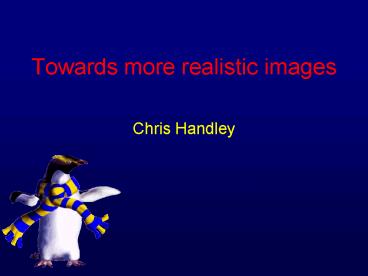Towards more realistic images - PowerPoint PPT Presentation
1 / 38
Title:
Towards more realistic images
Description:
A major problem is surface detail. Now what? Add more polygons or primitives. ... point on surface of the object (x,y,z) is mapped to a point in texture space (u,v) ... – PowerPoint PPT presentation
Number of Views:31
Avg rating:3.0/5.0
Title: Towards more realistic images
1
Towards more realistic images
- Chris Handley
2
Towards more realistic images
- So now we have an image.
3
(No Transcript)
4
Towards more realistic images
- So now we have an image. It still doesnt look
real.
5
Towards more realistic images
- So now we have an image. It still doesnt look
real. - A major problem is surface detail.
6
Towards more realistic images
- So now we have an image. It still doesnt look
real. - A major problem is surface detail. Now what?
7
Towards more realistic images
- So now we have an image. It still doesnt look
real. - A major problem is surface detail. Now what?
- Add more polygons or primitives.
8
Towards more realistic images
- So now we have an image. It still doesnt look
real. - A major problem is surface detail. Now what?
- Add more polygons or primitives. (slow!)
9
Towards more realistic images
- So now we have an image. It still doesnt look
real. - A major problem is surface detail. Now what?
- Add more polygons or primitives. (slow!)
- Add detail with a texture!
10
Towards more realistic images
11
Towards more realistic images
12
The Algorithm
- Mapping 2D (texture) image to a 3D object.
- Set up texture coordinates (u,v).
- Usually scaled to be 0.0 .. 1.0.
- Specify a texture location (texel).
- Each point on surface of the object (x,y,z) is
mapped to a point in texture space (u,v).
13
Texture Mapping
(x, y, z)
(u, v)
14
The Simple Case
Pixels
Texels
15
The Simple Case
16
Problems
- Tiling the area of the texture is smaller than
the area to be textured. - Scaling an object pixel is bigger (smaller)
than a texel. - When do we do the interpolation?
- How do we map a flat image (texture) onto a 3D
surface (sphere, cylinder)? - Animation.
17
Tiling
18
Tiling
19
Sampling
- Problems arise when there is a mis-match between
the size of a pixel and the size of a texel. - Much confusion in terminology authors are often
inconsistent and sometimes just plain wrong.
20
Over/Under Sampling
- Two situations can arise
- One pixel maps to several (many) texels
(under-sampling). - Several (many) pixels map to one texel
(over-sampling).
21
Under-sampling
22
The Texture
23
Under-sampling
24
Under-sampling
25
Over-sampling
26
Over-sampling
27
Interpolation
- Perspective projection is a non-linear
transformation. - Makes a big difference whether we interpolate
before or after. - For correct results, interpolate before
perspective projection.
28
Interpolation
29
Interpolation
30
Mapping onto a Sphere
31
(No Transcript)
32
(No Transcript)
33
(No Transcript)
34
(No Transcript)
35
(No Transcript)
36
(No Transcript)
37
(No Transcript)
38
Next Lecture
Anti-Aliasing































